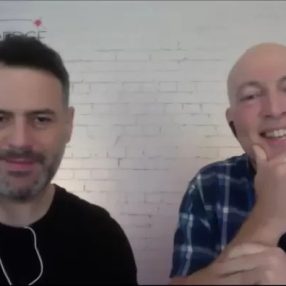
Overcome “No Decision” with Calum and John Podcast Transcript
No decision in sales is a huge pain point in modern B2B.
Calum, John and I discussed this at length and covered some other great areas including the issue of a crowded marketplace, and how to replicate the greatness of your rockstar salespeople through sales enablement. How can you get the other 60-70% of your sales team performing better?
This was a really enjoyable podcast, it was a pleasure speaking with Calum Kilgour and John Bissett from Slingshot Edge. Their company specialises in weapons grade messaging for sellers and marketers. Anyone in B2B sales will get a lot out of their insight.
Listen to the full 43 minute podcast here, or enjoy the transcript below.
Steven: Guys, I’d like to start off with what you’re doing in your business, and the key problems that you see with companies and with sales teams out there.
John: Sure, okay. Well, there’s three big problems that organisations have and that we try and help them with. Number one, is certainly in the complex selling world, this problem of no decision, but that could just be a deal that’s going from quarter to quarter and never apparently closing, so no decision is the number-one problem. The number-two problem is it’s a very crowded marketplace out there, more crowded than ever, so from your buyer’s point of view, to see why they should choose you is very difficult, so helping sellers differentiate themselves in the marketplace is the number-two problem. And number three? Well, I’m sure in every organisation there is a rock star salesperson or salespersoness, and really to have a massive impact to your company, if that’s your company, you want everyone to perform like that rock star. So replicating greatness throughout the sales organisation, from a sales enablement point of view, is number three.
Steven: Okay, so three big problems there: no decision, helping sellers differentiate themselves, and then replicating those top performers. Let’s dig into no decision first, there’s a lot of discussion in sales about that. What’s going on here, what’s going on with no decision?
John: Well, I think that one thing is it has become an increasingly more complex from a buyer’s perspective. Technology is getting more complex, the number of stakeholders, particularly in the enterprise software or tech space, the number of stakeholders that are touched by a new platform, a new solution, a new system, that’s becoming larger and larger. If we think about the number of people that have to give a consensus to move ahead, it’s becoming greater. Going back to my own experience in the airport world, previously I sold airport systems, Steve, operations and planning systems, and it was getting to the point in some of these tender presentations that you would walk into a room with a cast of a thousand there: you had people from finance, IT, operations, planning, all with their own vested interest in the solution. And that was one of the big challenges, is how do you create value for each of these people? And you’re not only selling software; you’re selling change, it’s change management, it’s a change to process, and that could be scary, that can be a risk for an organisation, big change is a risk.
Steven: Yeah. So there’s a lot of those folks there that can probably say no, right, they’re not that interested in saying yes, they want to make life easier for themselves, and it’s very hard for that champion to overcome that.
Calum: Yeah, so there’s loads of stakeholders. CEB’s great book The Challenger Customer, they’re now saying there’s 10 people, on average. It’s hard to believe, really; when we sell, I don’t think we ever speak to 10 people in the buying group, but they reckon there’s 10 people. But another reason for no decision is fear, is people’s sense of self-preservation. A lot of sellers probably don’t realise this, but whatever problem their solution is supposed to be solving, your buyer is probably already solving it, or at least addressing it in some way – probably not as beautifully as you’re doing it, but they’re still addressing it in some way – and up until now, whoever is in charge of addressing that problem, so far they’ve not been fired. And, as John said there, when you present your solution to them, you’re not just presenting software or whatever it is; you’re presenting massive change that has to run through their organisation. And because they’ve got all these stakeholders, whoever it is you’re talking to, if you’re just talking to one person, they as individuals have to articulate the reasons for change to all of these other people, and nobody has trained them how to do that, and from their point of view that’s very difficult.
John: Yeah, and they’ve got to put their neck on the line to do that. If they’re going to promote you and prioritise you and your project over some other project, they’re putting their reputation and neck on the line. You’ve got a million people in an organisation competing for budgets and projects, and to put your one forward is a big risk for that champion, it’s a huge risk. And how many large IT projects fail? It’s huge!

Steven: Yeah, 30-50-70%… It’s some risky proposition, isn’t it?
Calum: Definitely.
Steven: And that is true: buyers are maybe not buying these solutions that frequently, they don’t really know how to go about that.
Calum: Yeah, absolutely.
Steven: Alright, so that’s no decision. Maybe I could ask you about the crowded marketplace and helping sellers differentiate themselves. What’s the challenge there?
Calum: Sure. The challenge is, a bit like John said, walking into the cast of thousands: each individual is looking for their own personal value of your solution, so they’re going to select… Assuming you’ve got over no decision and they’re going to buy something, they’re going to try and, or you would think that they’re going to try and buy the solution that offers the most value. So from their point of view, they have to evaluate you. So that word “value” in itself is a problem. Because all the sellers are going “Yeah, we’ve got to offer value,” and the buyers are going “Yeah, we’ve got to select the ones who’ve got the most value.” If I even ask yourself, Steve, an expert in sales, just released a new fantastic book, what does value mean to you?
Steven: What does value mean to me? Well, it’s something that’s important to the customer, and putting it in the customer’s terms somehow, something around that.
Calum: Right. Well, imagine we had two or three of your colleagues there beside you, and then we went to one of your colleagues and we said, “What does value mean for you?”…
Steven: Yeah, I know where you’re coming from. Revenue growth or margin growth might be important to me, but the finance guy is more risk management or the order person.
Calum: Totally. So every individual has got their own definition of value. And when sellers say, “Yeah, we’re going to offer you some great value,” the seller doesn’t… nobody really knows what anyone means there, everyone has got their own interpretation; this is an abstract term. If I said, “Pick up some value,” it’s very hard to imagine what’s in my hand here, if that’s value. So it is not concrete. So that’s one of the problems: no one knows value is, and they’re all trying to select a solution based on value. Everyone is raving on about value, but nobody really knows what it means, or everyone has got a different definition. So that’s one.
John: The other one is if you have a look on any tech website… I did this in my previous role: I went around our competitors’ websites, and I took the copy and text off the websites, the homepage, I anonymised it, I put that on a document and I sent it around our business, and I said, “Tell me, which one of these paragraphs is from our website?” and no one could do it, no one could do it – they all looked identical! So as a buyer, it is really hard to differentiate when you’re browsing and doing that research. Because most tech companies, most sellers, are promising the same things: they’re talking about a solution, and they’re promising benefits, and they all kind of sound the same. So it’s very hard, from the buyer’s perspective.
Steven: Yeah, they’re saying, “We’re big, we’re number one in this space or we’re number on in that space, we’ve got 10 offices, we’ve got great support…”
John: Absolutely. “We can increase your efficiency, we can reduce costs, and we can improve customer satisfaction,” and you look at these things, and you say, “As a buyer, I can’t see a difference.” So it’s very hard, as a buyer, to distil that concrete, unique value for each organisation.
Steven: There’s a sea of sameness in everything that the customer sees.
Calum: You said the word “sea” there. When you think of the word “sea”, you think of billions of gallons of water, or billions of cubic kilometres of water. If you think of that as information, that is what it’s like for your buyer: there’s tsunamis of sea crashing, there’s so much information, and it’s very difficult for them to to simplify that down into something meaningful for them. The seller often… We call this the curse of knowledge – me and John suffer from it as well, maybe you suffer from it from time to time – we’re thinking about our solutions all the time, every day, how we can make them better, and we start to think almost in abstract ways, and the language that sellers use to their prospective buyers is often different from the language that the buyer uses themselves, so there’s a mismatch there.
It sounds pretty stressful actually, being a buyer: there’s loads of people trying to convince all around me, I’m getting washed with tsunamis of information, everyone sounds the same, I don’t understand what the hell people are talking about, and I don’t want to look stupid in front of them, I’m terrified I’m going to get fired… So that’s a pretty insecure job we’re talking about.
John: So then what do you do? You shortlist four or five potential suppliers, and they all look the same, they’ve all got fantastic reference sites. So what do you do? You evaluate on price.

Steven: Get into a price war, yeah.
John: Yeah, and it’s something that I saw over and over again. I mean, I’ve been in the tech space for 15-16 years, and buyers would tell you they didn’t want to evaluate on price. But if they can see no difference, that’s the one differentiator.
Steven: Yeah, absolutely. The third issue you mentioned was replicating the rock star salespeople. […] What’s the challenge here?
Calum: I think the challenge is that most of these top sellers, if you look at them, they don’t know what they’re doing different; they just do things naturally, it’s innate. They tend to have fantastic emotional intelligence, for a start, so they can adapt to a situation with a buyer. The Challenger Sale is a fantastic example: The Challenger Sale looked at the top 5-10% of sellers, and these guys and girls have fantastic emotional intelligence; the problem is that’s a very, very hard thing to teach. If you think about the distribution curve of sales talent in an organisation, the majority of your sellers are not the top 5-10%. It’s hard for them to understand what the top sellers are doing, and it’s hard for the top salespeople to really articulate what they’re doing differently as well, because they just do it naturally.
…We leave the interview there for now. Follow the link to listen to the full 43 minute podcast.
Listen to the complete Podcast with Calum and John.
Leave me your comments!



